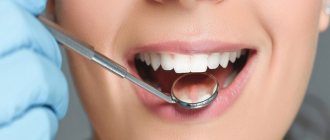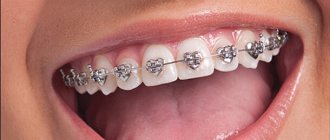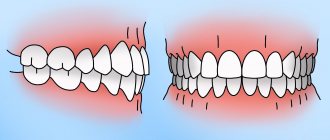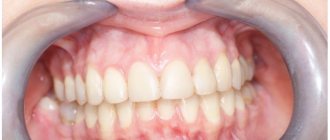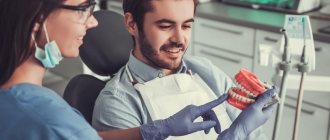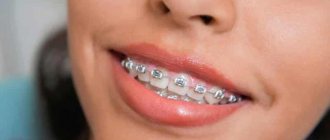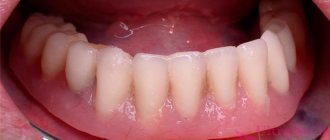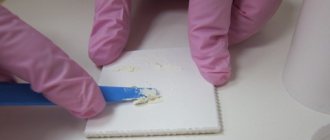There are cases when it is not possible to correct a malocclusion using braces and aligners, when it is not the pathological location of the teeth, but skeletal disorders in the jaws. Such as mesial or distal bite, when the lower jaw is located in front of the upper jaw or vice versa. In such situations, it is impossible to correct the bite using a conservative method. We resort to radical surgery to correct the bite - we correct the bite surgically, thereby lengthening or shortening the jaws and chin. Such operations can improve the profile of the face, make it more symmetrical and, as a fact, more attractive.
It should be clarified that operations to correct the bite are carried out during the period of completion of the formation of the jaws. Until the age of 18, the need for surgical intervention is decided strictly on an individual basis. Such operations are carried out if there are very serious deviations that are not amenable to other types of treatment.
In old age, these surgical interventions are recommended to be performed up to 60 years of age. If the patient is older, then the need for surgical intervention is decided individually, taking into account concomitant diseases.
In Krasnodar, surgical interventions to correct bites are carried out in many specialized clinics and hospitals.
How is a bite corrected surgically?
What is surgical orthodontics and when is it performed?
Radical surgical orthodontics is used to correct the bite when a change in the position of the teeth will lead to a deterioration in the patient’s condition, increased muscle tone, and, as a consequence, neurological disorders. With a mesial position of the lower jaw, or with its distal position, with pathological asymmetry of the face, when as a result of this the quality of life changes.
When a patient has a diction disorder that qualitatively disrupts his social life and alternative treatment does not lead to results, radical surgery is resorted to.
This manipulation is not performed in our clinic for a number of blood pathologies, for hormonal diseases, for immunodeficiencies, for children under 18 years of age, for diseases of a psychological nature.
The procedure itself is a surgical intervention into bone tissue. This manipulation is called osteotomy. The surgeon augments the bone or reduces its volume, makes an incision in the jaw, and can change the shape of the chin.
Smile in a Million
— It turns out that lingual braces are the most comfortable?
- I wouldn't say that. Lingual braces have the advantage that they are not visible, but from a therapeutic point of view this is a more labor-intensive and complex process. And, if it is not important for the patient which braces to fix, I will recommend him new generation braces - Damon 3 - System. They are quite aesthetic because the half of the bracket is transparent and there is no ligature, reduced size of the bracket, low friction forces in the system, less traumatic effect on the moved teeth and surrounding tissues, which greatly reduces the duration of treatment, less pain, more comfort for the patient, which generally improves the quality and effectiveness of treatment. Now modern technologies are emerging that allow the use of a lingual system, manufactured individually for each patient in a special laboratory. - But it probably costs much more? - More expensive or cheaper - the concepts are very vague. Everyone decides this for themselves. If parents try to cure their child, to give him a beautiful smile for life, they do not save, but, on the contrary, invest in their child, in his comfort, in his future. Otherwise, a complex person may grow up, embarrassed to say a word, hiding his smile... A beautiful smile is a psycho-emotional factor, a health factor, and a social factor. Investment in orthodontic treatment is the best investment in life, health, beauty, image, individuality. The leading role in a person’s appearance belongs to the face, and on the face – a smile. If it is believed that the eyes are the mirror of the soul, then a smile is a reflection of the heart. Back
Indications for surgery
Today, patients themselves can insist on orthodontic surgery, or the doctor insists on this type of surgical intervention.
Indications for radical surgery to correct the bite are:
- significant underdevelopment of the lower jaw, or an upper jaw that is too forward
- if the teeth do not close in the lateral or anterior sections, the so-called open bite, which interferes with normal chewing of food
- if there are abnormalities in the development of the chin
- when the patient has significant diction problems
- if the patient received injuries that led to jaw deformities.
Contraindications to surgery
Correction of the bite in a dental clinic by surgical intervention is not performed in children and adolescents, as well as in older people. The operation involves risks, so there are restrictions on its implementation.
Surgical bite correction is contraindicated in patients who have:
- pathologies of the cardiovascular system;
- blood diseases, including poor clotting;
- diseases of the skeletal system;
- dysfunction of the endocrine system;
- severe form of diabetes mellitus;
- mental illness;
- immunodeficiency diseases;
- acute inflammatory, infectious or viral diseases.
Surgical treatment of malocclusions is not performed for aesthetic purposes. The main task of the maxillofacial surgeon is to restore all functions for which the dentofacial apparatus is responsible, as well as eliminate concomitant pathologies.
Preparation
Preparation for the operation to correct the bite is carefully carried out by our doctors; all plaque and tartar are removed; for this, a qualified hygienist will perform a series of manipulations to remove supragingival and subgingival deposits.
A general practitioner and a surgeon will treat caries and its complications, and remove teeth that have been destroyed at the root. In our clinic you can undergo all the necessary examinations before surgery and have a computed tomogram done on the latest tomograph. The dentist-surgeon together with the orthodontist will plan the future result and make a template.
Diagnosis of mesial occlusion
As can be seen from the above, mesial occlusion has signs. And there are reasons. And these concepts should not be confused. Those. You should not treat the signs (“third class closure” or “protruding lower jaw”). The cause needs to be treated. Before that, of course, it was determined diagnostically.
Diagnosis is the first and key step in the treatment of mesial occlusion. Do you want to know why it is impossible without diagnosis?
In addition, the causes of mesial occlusion, as can be seen from the text above, can be divided into dental and skeletal. And skeletal causes can be divided into jaw and postural (related to posture). And all these reasons can be combined in various ways.
In general, in order to clearly understand the cause of mesial bite, in each specific case, a diagnosis is needed. Only after analyzing the diagnostic data will it become clear how and with what to treat mesial occlusion in this particular patient.
The main types of diagnostic studies for mesial occlusion are:
- analysis of lateral TRG (teleradiogram). It allows you to identify jaw factors (size and position of the jaws) of mesial occlusion
- analysis of jaw models (dentition). It allows you to identify the “dental” causes of mesial occlusion
Analysis of lateral TRG.
Analysis of jaw models.
Progress of the operation
Surgical correction of the bite is carried out in our clinic under general anesthesia under the guidance of an experienced chief physician and anesthesiologist-resuscitator and orthodontist. The duration can take from 15 minutes to 4 hours in complex cases. The operation itself includes the surgical stage itself, when access to the bone is carried out surgically through soft tissue in order to correct its position. The surgeon performs manipulations to reduce or increase the volume of bone tissue, or to displace it using a special surgical set and elements for fixing the bone (various splints, screws).
If the patient’s condition allows and there is a need, braces are installed immediately after surgery. After surgery, a fixing bandage is applied to the face. Sutures are placed on soft tissues, and the wound surface is treated.
In complex clinical cases, due to the proximity of other organs to the operated area, we involve the appropriate specialists - ophthalmologists, plastic surgeons, otorhinolaryngologists.
Since the operation is performed exclusively under general anesthesia, it is painless for the patient, under constant monitoring of the condition of vital organs and systems by an anesthesiologist.
Classic vestibular braces
They are also external braces - the most common. These braces are fixed on the outer surface of the teeth, the one we see when we smile.
Vestibular braces are the most popular system for correcting malocclusion, but they are not the only one, including for adults.
Ligature braces (the arch is secured with special rubber bands - ligatures)
Advantages of external braces in the treatment of malocclusion:
- This is the most functional device that we can use in adults. Corrects all possible malocclusions. If the case is complex and surgery is needed, braces are worn before or after it. In addition, they can be supplemented: install springs, rods, buttons, ligatures, chains for pulling out impacted teeth. The more complex the pathology, the greater the likelihood that something additional will need to be tightened, and this is where such a wide functionality of braces comes in handy.
Example: a spring connects the braces and forms the bite
- The second plus is a consequence of the first: braces provide the maximum effect of expanding the dentition. If the row is significantly narrowed compared to the norm, braces are most preferable. In addition, the narrowing of the dentition is most often accompanied by the absence of some teeth (that is, they are there, but are located inside the gums - they remain impacted). And pulling out impacted teeth using an arch of braces is justified and convenient.
- Price. You can choose to suit any budget. Expensive - transparent sapphire and for a relatively small amount - metal. Visually they are less attractive, but no worse in efficiency.
Aesthetic ceramic braces are less noticeable.
External braces also have disadvantages. Moreover, they are the same for any system, both the simplest metal one and the aesthetic one with white or transparent braces.
- Any external braces, even white-painted arches, are still noticeable. And this often influences the choice: not all adults are ready to wear them. Although no one is surprised by braces for a long time, and no one pays attention to them, for many it is still a psychological barrier.
- It is more difficult to maintain hygiene. Although adult patients usually take a conscious approach to treatment and follow all recommendations, force majeure nevertheless occurs: trips on vacation or a business trip, where there is no time or it is inconvenient to constantly brush your teeth after eating. Braces are a non-removable structure, you have to eat with them, and leftover food remains on them. You have to spend about 20 minutes on each brushing (about an hour a day in total), otherwise plaque will form, which increases the risk of developing caries. Braces themselves do not cause caries and do not spoil the enamel - plaque damage due to poor hygiene does.
- Wearing braces hurts. Although this is subjective, it all depends on the individual and pain threshold. In the first days after activation of the system (it is carried out every month), some patients sometimes have to take pain medication. In addition, the protruding parts of the braces can scratch the oral mucosa and rub it. For most patients, this goes away within a few days, while others experience discomfort from such side effects throughout the entire treatment period. But you can seal the protruding areas of the braces with orthodontic wax.
This is what braces with protective wax look like
- You are not allowed to eat all foods with braces, even after the pain subsides. Avoid solid foods - hard fruits and vegetables, nuts. Chewing meat also becomes difficult, as fibers become clogged in the space between the teeth and the arch. The fact that you will have to eat food pureed through a blender for a year is an exaggeration, but you can forget about some delicacies for a year and a half.
Braces are effective for treating adults, but you have to come to terms with the shortcomings of this technology. Spend a lot of time taking care of your teeth, limit yourself to certain dishes, get used to your smile with “decoration”.
Recovery period
The recovery stage after surgery is the longest. Since maxillofacial surgery, which is performed to restore malocclusions and straighten teeth, with distal occlusion in adults, the jaw often has to be broken, which is a complex surgery, and the recovery process in such patients takes longer and is quite painful.
In the postoperative period, there may be an increase in temperature, pain, and swelling of the face. It is important to strictly follow the recommendations that the surgeon gives after the operation.
The doctor will prescribe you a number of medications, give you all recommendations on nutrition, hygiene, and prescribe follow-up examinations and suture removal.
The healing period depends on the extent of the intervention and, as a rule, lasts from several weeks to 2 months.
Our specialists are in touch with patients around the clock, which allows us to reduce postoperative complications to zero.
Rehabilitation
After surgical correction of the bite, the patient should be prepared for long and complex rehabilitation. Immediately after the operation, a splint is applied to the jaw, and the entire head is covered with a bandage, which prevents bone displacement and also reduces swelling. The bandage is removed after a few hours, and the splint can be removed only after two weeks of rehabilitation.
Features of the recovery period:
- If you have a splint, you should not open your mouth wide, actively move your jaws, blow your nose sharply, close your nose when sneezing, or chew food vigorously;
- taking antibiotics for 5–7 days;
- sutures are removed after 10–14 days;
- screws - fasteners are removed after 4 months.
In the first days, bruising, difficulty speaking, difficulty eating, pain in the jaw and headaches are possible. There may be numbness in the area where the jaw was cut. Gradually all symptoms disappear. Complete rehabilitation takes from 1 to 3 months. After complete recovery, you can evaluate the result.
Before and after results
Results before and after surgery will vary significantly. Depending on the scope of the surgical intervention, the type of pathology or injury, it depends on when the first results of the operation can be seen.
If the surgical intervention was extensive, screws, screws, pins were installed, then the result can be seen in a couple of months. The patient undergoes CT and TRG to assess changes in jaw position.
If screw fastenings were used during the operation, they are removed after 3-4 months, after which the result of the surgical treatment is finally assessed.
The final result of the operation depends both on the professionalism of the surgeon and on the patient’s compliance with all the doctor’s recommendations. The correct behavior of the patient during the rehabilitation period affects the final result of the surgical intervention.
Get a consultation
We will answer all your questions before visiting the clinic!
+7
Online registration
Orthodontic plates for teeth
Orthodontic plates are devices that combine plastic and metal. The base of the structure is made of plastic and is fixed on the palate or gum under the tongue, and metal guides work with the teeth. Also, some plates have an additional built-in specialized screw, which is responsible for expanding the jaw or extending the segment.
Plate operation . Orthodontic plates can:
- Move specific units. The arches tend to return to their original position, therefore, as in braces, putting pressure on the units moves them.
- Change the width of the dentition and palatine bone. A special key is used to rotate the screw built into the plate. With each rotation of it, the plate expands, which leads to rupture of the palatal suture and the formation of additional space in the dentition. Thus, an incorrectly erupted tooth can fall into place.
- Adjust the height of jaw closure. With a deep bite, plastic parts of the plate are placed on the chewing group of teeth, which help to raise the bite and create space for the growth of other units.
Plates in orthodontic practice are mainly used in the treatment of children with primary occlusion, when the jaw bones are still growing and respond well to therapy. It turns out to be very effective in preventing the formation of jaw pathologies. In adult patients, plates can be used in the retention period, at the end of treatment, to maintain the achieved result.
Varieties. There are removable and non-removable plates that are used for the upper and lower jaw:
- with a hand-shaped process – corrects the position of individual units or groups of teeth;
- with a retraction arch – alignment of the entire dentition;
- Andresen-Goipl activator - a two-jaw removable device that avoids the formation of defects at the stage of primary occlusion;
- The Marco Ross apparatus is a non-removable structure that is fixed to the sixes with rings and expands the jaw with a screw. This provides space for the molars.
- Frenkel apparatus is a complex system of four types with additional accessories for correcting malocclusion.
- Bruckle apparatus – corrects anomalies in the position of the lower incisors.
Pros: reasonable cost of equipment, ability to remove plates if necessary, standard oral hygiene, correction of jaw abnormalities at an early age.
Minuses. Plates do not correct the bite completely, but only individual anomalies. If you want to achieve a perfect smile, you will need to install braces.
Price. The cost of manufacturing a device with fixation in the oral cavity starts from 5 thousand rubles, but varies depending on the purpose and design of the device.
Trainers for teeth straightening
Orthodontic trainers – silicone mouth guards for correcting malocclusion in adults. At the start of therapy, soft pads are used for comfortable adaptation, which are later replaced with harder ones for effective correction.
Mouthguards can only work at night during sleep, because it is impossible to eat, drink, or speak in them. During the day, the device is worn for 1-2 hours.
Such equipment can correct minor defects in the bite, as well as correct the position of the tongue, normalize nasal breathing and swallowing.
Pros. The mouthguards are standardized sizes, there is no need for individual adjustments. They do not affect appearance and social life, because they are used at night. They are easy to care for - brush your teeth at night, and the mouthguard should be rinsed under running water.
Minuses. They cannot correct severe pathologies, and the correction of small defects takes a long period of time.
Price: from 2 thousand rubles.
It turns out that correcting the bite in adults without braces, namely with trainers, is possible only with minor violations.
Aligners – transparent aligners
Aligners are a set of transparent aligners made according to individual characteristics from impressions of the patient’s teeth. They are made of thin plastic, transparent and show excellent results. At Implantmaster, aligners are an alternative to braces for correcting malocclusion in adults. 3Shape Trios scans the oral cavity (the modern equivalent of taking impressions), and then creates a 3D model of all the movements of the units to a healthy smile. Such technologies are used only for aligners.
Correction technique. Mouthguards for correcting malocclusion in adults require constant wearing, and they can only be removed before eating and brushing your teeth. To correct bite anomalies with aligners, it is necessary to replace the aligners every 2 weeks with a new pair.
Positive characteristics of therapy:
- high aesthetics;
- show good results;
- do not cause allergies;
- after 2 days of adaptation they do not affect speech;
- All therapy takes up to 1.5 years.
Minuses. The cost of general treatment with aligners, due to the high cost of replaceable aligners and 3D technologies, is very high. Frequent visits to a specialist are also necessary for correction and obtaining a new set of aligners.
Price. Aligners for correcting malocclusion in adults will cost 350 thousand rubles at Implantmaster.
Indications for use. Correction of minor violations of the arrangement of units and the retention period after completion of treatment on the brace system to maintain the result.
How much does orthognathic surgery cost in Krasnodar?
The cost of the operation includes the operation itself and the post-operative period.
Orthognathic surgery without a postoperative period costs about 200 thousand rubles. The postoperative period will cost about 100 thousand rubles.
Patients in most cases are satisfied with the surgical intervention. They note an improvement in their quality of life. But for some, the disadvantage of this type of operation is the high cost. Since this type of operation is a planned operation of moderate severity, it is possible to carry it out under compulsory medical insurance. The waiting period can be more than 6 months.
Prosthetics for deep bite
The task of the orthopedist in this case is to eliminate damage to the mucous membranes, recreate occlusion (touching of teeth when closing), evenly distribute the chewing load and restore the height of the lower part of the face.
To do this, the occlusal surfaces of the teeth are leveled by grinding away the hard tissues. If a large number of units are missing, partial removable dentures with occlusal overlays are used. If the teeth are intact, the bite is corrected with crowns.
Minor defects
If there are anomalies in the size and shape of the front teeth, the position can be corrected without the intervention of an orthodontist. Veneers and crowns change the shape, close diastemas (gaps between the front teeth), tremata (gaps between other teeth), and visually increase the size of the teeth. Increasing the height of the bite has a positive effect: the lower jaw that has moved back returns, this reduces the load on the temporomandibular joint. The pain and clicking go away. Facial proportions are restored and posture is straightened.
TO SUM UP:
Summing up all the necessary stages, the minimum cost of correcting a bite using a simple metal brace system will be = 500 + 3,000 + 30,000 + 30,000 + (36,000 * 2 jaws) + 18,000 = 153,500 rubles.
Those. for two years of treatment you will spend the amount of 153,500 rubles.
If we divide this amount by 24 months (average treatment time), we find that the average financial burden for one month over two years will be 6,396 rubles.
To summarize, we can say that yes, the cost of braces varies greatly. However, no matter what brace system you choose, the result will exceed all your expectations, the treatment time in the positive environment of the ArtDental clinic will fly by quickly, and you will have a beautiful and happy smile!
Prosthetics for crossbite
Intervention is possible only with the skeletal form of the anomaly, if the patient has refused other types of help. In a preserved dentition, crowns are installed on the lateral teeth. If there is a large overlap, the natural crown (the part of the tooth that is visible) is shortened, cutting off the excess. If there are missing teeth, bridges are used.
If the teeth are slightly tilted, preparation is limited. For large deviations, tabs are used, changing their axis relative to the axis of the root. Such dentures are used for malocclusion if the deviation does not exceed 15 degrees. A crown is placed on top of the stump with an inlay.
So what exactly does the cost of a braces system depend on?
Let's start with something simple.
In a simple metal brace system, the braces are metal, the arch is fixed with “ligatures” - silicone rings. (Ligatures also come in both transparent and colored, but this does not affect the price.)
In a self-ligating brace system, the braces are also metal, but the arch is fixed with a “lock” on the bracket, which allows you to fix the arch more firmly, and therefore work faster, i.e. correct the bite. At the same time, the bracket itself is slightly smaller.
For those who want to visually hide the presence of a brace system on their teeth, there are so-called “aesthetic” brace systems. These are ceramic - “white”, sapphire - “translucent” and a slightly more affordable option, combined braces, i.e. In such a bracket system, the front six brackets located in the “smile zone” are ceramic or sapphire, and the rest are metal.
All aesthetic brace systems can be either simple (the arch is fixed with “ligatures” - silicone rings) or self-ligating (the arch is fixed with a “lock” on the bracket).
